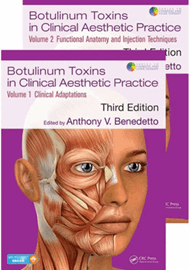This comprehensive guide comes in two volumes. Volume one considers the clinical adaptations of the various toxins and how they can be used with other injectables such as dermal fillers, light and energy base devices. It explores the use of botulinum toxin on the face and the body, discussing the medicolegal, psychological and cultural considerations.
The story behind the discovery of how botulinum toxin could be used cosmetically is well known to most and one can never tire of hearing about the ‘Eureka moment’ when Jean and Alistair Carruthers made clinical history.
Chapters covering the many conditions beyond hyperfunctional facial lines and hyperhidrosis, including migraine and incontinence, serve to remind us that potentially every muscular function of the body can be treated – thus illustrating the versatility of this product.
There are chapters that explore in detail the pharmacology, immunology and variety of different botulinum toxins in use around the world with experts cautioning about off-label use and the risks of counterfeit products.
Detailed guidance on how to undertake advanced upper and lower face treatments is provided and should inspire the reader to develop a deeper understanding of the art of aesthetic facial shaping – eyebrows, noses, eyes, lips, necks and chins in expert hands can help aesthetic patients to not just look good but to look fantastic.
Volume one describes the functional anatomy and injectable techniques. This volume systematically explores different areas of the face and body, explaining the ageing process. Attention is paid to the different patterns of muscle contraction during facial expressions and thus clarifies how a suitable treatment plan can be crafted. These procedures include treatments for the glabella, forehead, crow’s feet, bunny lines, lower eyelid, nasolabial folds, gummy smile, upper and lower lip, chin, neckline and décolletage.
The content of the book is well illustrated with photos and anatomical graphics showing how to safely undertake a variety of different procedures.
Options for different dilutions and dosings are shared with tips on how to achieve the optimum outcome. Complications are discussed and advice given on how to avoid and / or manage obvious pitfalls.
The chapter discussing the use of botulinum toxin to improve the aesthetics of the breast in both male and female is illustrated with some impressive photographs. This chapter also highlights the use of botulinum toxin in relieving muscle spasm and reminds us of its value in managing neurological conditions.
The chapter discussing the ethnic variations between Caucasian and Asian populations reminds us to be mindful about what is aesthetically appropriate. The brief description of body muscle contouring, which is currently very popular in South East Asia, highlights the importance of recognising that there are different cultural perceptions and expectations of what constitutes ‘beauty’. This is essential reading in this increasingly cosmopolitan world.
Despite the focus on just how effective this toxin can be in reducing unwanted expression and highlighting desirable features, these books do not lose sight of the importance of humans being able to successfully communicate emotions between each other. In paying attention to such costs and risks which may result from cosmetic intervention we are reminded of our responsibility of “Primum non nocere” – first do no harm.
This informative and lively tome of knowledge has received contributions from many of the world’s leading experts and should be considered to be the essential authoritative guide to any practitioner who aspires to become a skilled artist in the aesthetic community.





